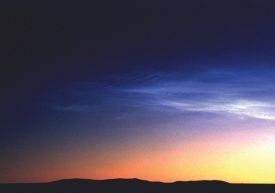
Indicators of climate change
Noctilucent clouds are the highest clouds in our atmosphere, usually found at a height of 83 km (50 miles) or so and in the past were only observed in the polar regions in summer.
The first recorded sightings of noctilucent clouds was way back in 1885 but the presence of these clouds has been increasing in both frequency and brightness and they are also appearing lower and being seen away from the poles.
The reason for their spread seems to be connected to the increase in methane and carbon dioxide in the atmosphere. Scientists are now viewing the clouds as very sensitive indicators for what is happening in our atmosphere and may be related to climate change.
Meteoroid dust in the upper atmosphere provides the base for water vapour to condense on, and create ice crystals in the cold temperatures, leading to cloud formation.
When the sun hits the ice particles (usually at twilight) they create a silvery or bluish-white colour and tend to appear wavy due to high altitude winds.
Although The clouds have been observed thousands of times in the northern hemisphere, there have been less than 100 observations in the south which may be due to a lack of observers or possibly atmospheric differences.
The Australian Antarctic Division is currently studying the clouds to find answers and you can find out more about them below.
